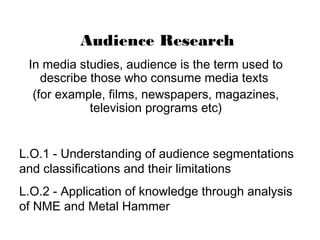
Audience research pp
- 1. Audience Research In media studies, audience is the term used to describe those who consume media texts (for example, films, newspapers, magazines, television programs etc) L.O.1 - Understanding of audience segmentations and classifications and their limitations L.O.2 - Application of knowledge through analysis of NME and Metal Hammer
- 2. Socio-Economic Classification • What products would you expect each socio-economic category to be interested in? • What magazines would you expect them to buy? • Be prepared to feedback to the class…
- 3. • What other ways can you categories audiences?
- 4. Psychographic profiling – Psychographic profiling is designed to test audience responses by attitude., they are based on the ‘inner qualities’ of a person. – For example, a questionnaire would be sent to targeted sections of the population with questions to respond to such as “on a scale of 1-5, with 1 representing “strongly agree” and 5 representing “strongly disagree”, respond to the following statements: “A woman’s place is in the home…….” Etc. – Personality - lifestyle - values - activities – Interests - opinions
- 5. Segmentation • Mainstreamers – make up about 40% of the population. They conform to the dominant ideology, more or less. They like security, follow set patterns of work and leisure and enjoy a sense of belonging. They are jogging along quite nicely, financially, but are not high-flyers. • Succeeders – People who have already got status and control and are high earners, at or near the top of their field. They are affluent and comfortable. • Aspirers – people who desire status, success and the esteem of others. They are ambitious and like status symbols, such as designer labels and expensive items such as impressive cars, jewellery, etc. They aspire to be wealthy and influential. • Reformers – people who are less selfishly motivated and believe in making a difference to the world they live in. They define themselves by self-fulfilment and self-esteem. Likely to be in the caring professions.
- 6. Geographic – Region (from neighbourhoods to continents) – Size and density – Climate Demographic – Ethnicity – Gender – Family size – Family cycle (e.g. full-nest, empty nest, double income no kids ) – Generation • (Baby boomers/Generation X/ Generation Y) – Income – Religion
- 7. Audience Research; What other ways can you divide audiences? • Psychographic profiling contd – Psychographic variables often relate to the aspirations of the consumer – the type of person they would like to be, for example… – Aspirational types found in younger audiences: • Trendies – those who crave the attention of their peers • Egoists – those who seek pleasure • Puritans – those who wish to feel virtuous • Innovators – those who wish to make their mark • Rebels – those who wish to remake the world in their image • Groupies – those who just want to be accepted • Drifters – those who are not sure what they want • Drop-outs – those who shun commitment of any kind • Traditionalists – those who want things to stay as they are • Utopians – those who want the world to be a better place • Cynics – those who have something to complain about • Cowboys – those who want to earn easy money (Selby & cowdery 1995: 25)
- 8. Applying Audience Research to NME and Metal Hammer • In pairs find the answers to the following questions (remember you need to reference the source): – Who is the CORE BUYER of your magazine? – Are they targeting a niche/small or mass population? – How do they target different audiences? • What do they offer them in terms of the products they offer/produce • What opportunities do the audience have and how might this satisfy mainstreamers/succeeders etc ? – What it the mode of address? (“The way a media text speaks to its target audience in order to encourage the audience to identify with it.” - the manner, tone and attitude of the magazine) and how does this appeal to the target audience? – How is the brand being positioned? – What are the brand values? If it were a person describe its character…. • Be prepared to feedback to the class!
- 9. Support http://www.alexa.com/ - collects data on internet browsing so this can be sent to company so they can understand how their consumers are using their sites (time spent on site etc) http://www.abc.org.uk/Data/ReportProductPicker.aspx?ttid=89 - will give you circulation figures for your magazine http://www.nrs.co.uk/toplinereadership.html - will give you some great information on demographic profiling of your magazine • If you haven’t done so already download NME and Metal Hammer readership profile (these can be found on Learnzone and my blog)
